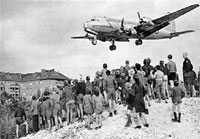This Day in History: September 30, 1949
Additional Date: September 30, 1949
The Berlin Airlift provided tons of supplies to war ravaged Berlin. Under the aid program known as the Marshall Plan, the USA supplied aid to the Western Allied zones, and economic recovery got underway.
The Soviets responded by stopping all highway, rail, and water travel between Berlin and western Germany. The Soviets hoped to force the Allies out of Berlin. However, the Allies set up the huge Berlin Airlift and flew tons of supplies into the city every day.
The Berlin Airlift dubbed, 'Operation Vittles,' carried out 300 000 flights and transported two million tons of supplies during the 406 days of the airlift. Some 441 American aircraft were used in total and they carried over three-quarters of the entire load into Berlin. At the commencement of the Airlift, many countries of the British Commonwealth, including South Africa, offered their assistance. These Commonwealth countries provided crews to fly RAF aircraft. South Africa sent ten complete Dakota crews, who flew for almost the whole period of the Airlift alongside their RAF colleagues. During this time South African air crews carried out a distinguished and accident free record of service. The Soviet blockade of Berlin was finally lifted at one minute after midnight, on 12 May 1949, and the first great standoff of the Cold War was over. Flights continued for some time, though, to build a comfortable surplus. By 24 July 1949, a three-month surplus was built-up, ensuring that the airlift could be re-started with ease if needed. The Berlin Airlift officially ended on 30 September 1949, after fifteen months.
